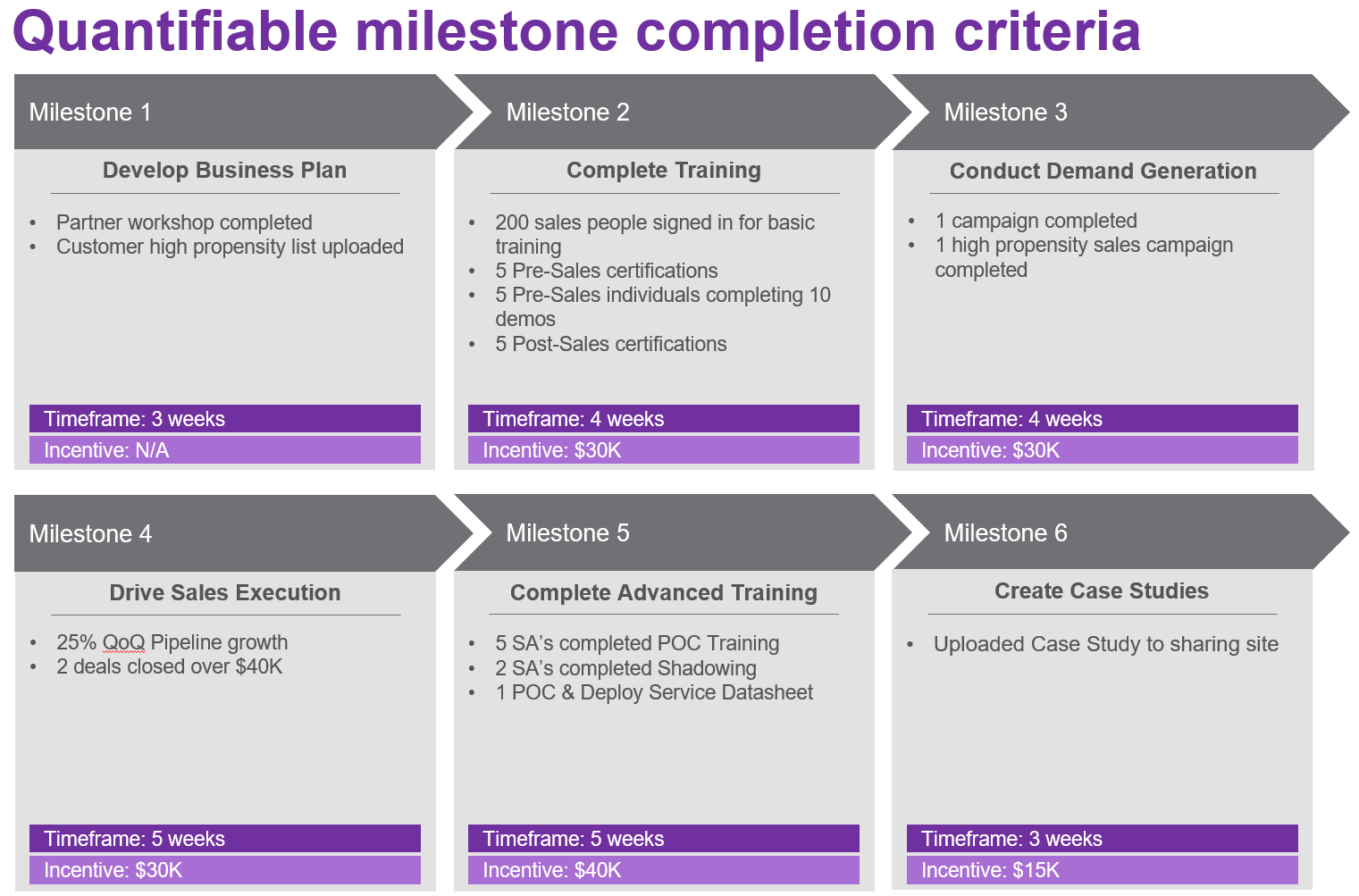Let's say you've previously recruited partners for your channel — maybe by referencing the key elements needed to do so in our recent partner recruitment blog — and obtained top-notch talent that is ready to sell.
Now what?
You can throw your partners to the wolves with all the necessary selling guides in the world, but this won’t ensure their success or commitment. Without proper partner onboarding, you could experience drop-off before you get a return on your investment. To instead have a well-established relationship, you need to provide them with three things during the partner onboarding process:
1. Quantifiable milestones for partner onboarding
Milestones are the meat and potatoes of creating success during and after partner onboarding; they create a path for your partners towards an eventual goal. If a company provides an end goal and quality training material on a product, but no path to get there, you can bet that even the most talented will begin to drop off. During the partner onboarding process, you need to lay down the stepping stones, and you need to do so in a way that is simple for them to understand and follow.
Boost morale
When you construct milestones you are inventing small opportunities for your partners to feel accomplished. While providing a sense of direction, milestones during partner onboarding are confidence boosters that spur determination and commitment.
Make it measurable
Don’t tell your partners to “sell more.” What does that mean? You need to define success clearly and explicitly to see the results you want. Instead, tell them to “sell to 5 new companies each larger than 20,000 people.” Partners will appreciate the clarity of your direction and respond better to it. It will also allow you to better track how they are progressing.
Prepare for long term repetition
If you are creating your selling process and materials for the long term, you need to have them be operational for multiple rounds of channel recruits. Therefore, your partner onboarding milestones should be able to be repeated by every partner you have over and over again. Don’t define milestones with one partner in mind and have different partners struggle.
Below is an example of actionable, replicable milestones a company might have during channel partner onboarding:

What makes these milestones as opposed to tasks? They are being tracked to a timeline.
2. Creating an actionable timeline during the partner onboarding process
Having timeframes associated with each milestone, which is depicted in the above slide, is crucial to the onboarding process. Without a timeline partners can still make sales, but slowly on their own relaxed time.
Keep your account managers happy
If a partner is moving too slowly, your account managers will start to focus their efforts on new recruits. An account manager doesn’t want to continue investing in someone who isn’t generating revenue; that makes them look bad. Tracking milestones to a timeline in a reasonable way accelerates partner success, keeps your business looking good, and keeps your account managers satisfied.
Have regular check-ins
Milestones shouldn’t be the only markers on the timeline. It may feel like babysitting, but check-ins help keep partners accountable. Partners don’t want to disappoint, so if you tell them you are going to check on their progress 3 weeks down the road they will want to have something to show you. This is why we also advise putting check-ins in between milestones. If they should be about halfway towards a goal, but you check in and they have barely started, you now know they need your help. Without the check-in, you wouldn’t have otherwise gotten this insight and been able to push them back on track.
Below is an example of a timeline that aligns with the milestone graphic above:

Now they have milestones and a timeline, but how can you ensure they track to it?
3. Incentives that align to the field
You may have noticed in the first image that there are also incentives matched to each milestone. Monetary goals are the extra push that some partners need to drive the sale. Most customers we work with seem to understand why this is necessary, and tell us that it has helped their partners stick to the timeline and persevere on a sale when they otherwise might not have.
Go two steps beyond partner incentives
What many of our customers don’t think about is looking past incentivizing just the partners. The step beyond this is incentivizing the field members. Wait - there’s more – two steps beyond this is knowing that field incentives also need to be aligned to the partner incentives.
This alignment aspect is the key to successful channel partner onboarding. Partner rewards are tied to milestones, so field rewards should be tied to the same milestones. When a partner makes their first sale, the partner and the field member who helped them get there should both receive a monetary reward. The field members share responsibility with the partner; they are on the same team. The field member is more likely to push a partner towards a milestone when it benefits both parties.
Use incentives to increase visibility
Incentive alignment during partner onboarding gives field members more visibility into a partner’s schedule, because they have the same one. A field can provide more tactful advice and resources if they are more knowledgeable about the seller’s path.
To learn more about how to structure incentives, view our previous blog on the subject.
Don't commit the biggest danger in channel management
In short, setting your partner up for success helps you achieve success. The biggest danger in partner onboarding, and what we tend to see most often, is that people will identify a recruit, send them a bunch of to-dos, and move on to the next partner.
Lay down your stepping stones and don’t have them get covered in moss. Stick with your partners long enough to see them succeed and receive a return on them as an investment. Create milestones, generate a timeline, and align your field and partner incentives.

.png?width=300&name=SR2025-ps%20(43).png)